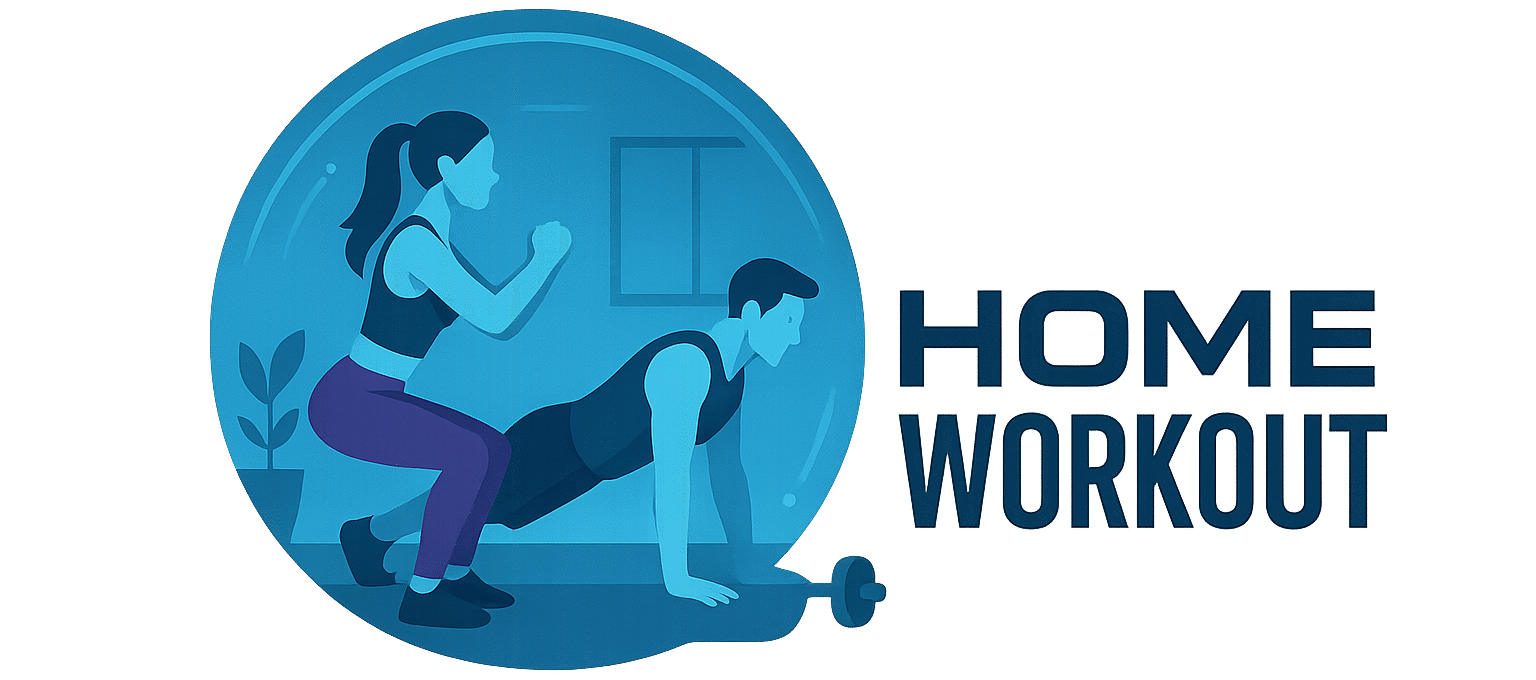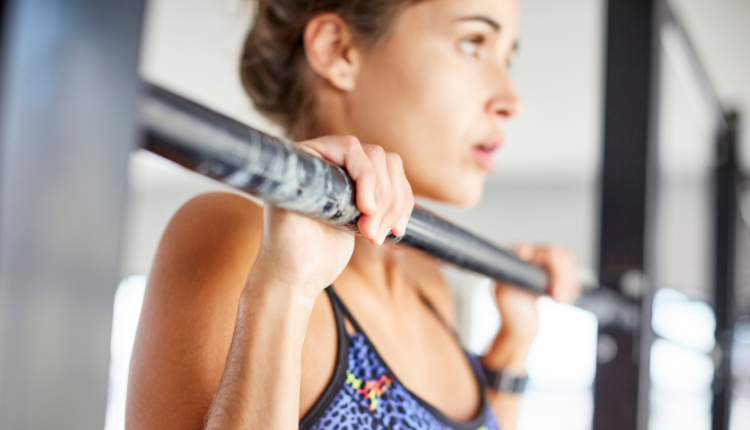
Any type of research you do regarding workout and fitness equipment will mention the pull up bar as one of the favorites. Beneficial to both women and men, this piece of workout equipment provides fitness enthusiasts with a variety of exercises which we will take a look at below. In addition, we will examine a number of these pull up bar at home products which hopefully assist you in choosing the best fit for you. .Whether you’re a fitness enthusiast or just starting your strength journey, a home pull-up bar provides the perfect foundation for building impressive back, arm, and core strength right where you live. Let’s get started:
This post contains affiliate links. As an Amazon Associate, I earn from qualifying purchases. If you click and make a purchase, I may earn a small commission at no extra cost to you.
Benefits of a Home Pull Up Bar
Let’s now turn our attention to the benefits these products provide. As we take a look below, these home pull up bars deliver fitness advantages that extend far beyond just convenience. This simple piece of equipment creates opportunities for transformative strength building that be accomplished right at home. Let’s now take a look at other benefits that you may have not considered.
- Versatility: It can be used for multiple exercises targeting different muscle groups.
- Space-Efficient: Most pull-up bars take up minimal space.
- Bodyweight Training: Great for building strength without weights.
- Cost-Effective: Generally inexpensive compared to other gym equipment
- Space-saving: Doorway-mounted and other compact options are ideal for apartments or smaller homes where dedicated gym equipment might not fit.
Strength Building Efficiency
Did you know that pull-ups are widely recognized as one of the most effective compound exercises for developing upper body strength? A single pull-up engages multiple muscle groups simultaneously, including your back, biceps, shoulders, and core. This makes your pull up bar at home workout incredibly effective – you’re targeting several muscle groups with just one movement pattern. Good stuff!
Cost-Effectiveness
When comparing the price of a quality pull-up bar (typically $30-$200 depending on the type) to an annual gym membership ($300-$1,200), the financial benefits become immediately clear. A one-time investment in a pull-up bar can provide years of effective workouts without recurring costs.
Additionally, a home pull-up bar eliminates transportation costs and time spent traveling to and from the gym. This efficiency adds up significantly over time, making it one of the most cost-effective fitness investments available. This may help to explain why this workout equipment remains a popular choice.
Space Efficiency and Accessibility
Unlike bulky home gym equipment that dominates your living space, most pull-up bars have a minimal footprint. Doorway models can be quickly installed and removed as needed, while wall-mounted options utilize vertical space that’s often underused in homes. Even free-standing models can be positioned in corners or against walls when not in use.
Having a pull-up bar at home means you can exercise whenever it fits your schedule – early mornings, late evenings, or quick sessions between other activities. This accessibility removes common barriers to consistent exercise, helping you maintain a regular workout routine without scheduling constraints.
Types of Pull Up Bars for Home Use
Selecting the right pull up bar for your home depends on your space, installation preferences, and workout goals. Each type offers unique advantages to consider when planning your pull up bar at home ideas. Here is a great list to gey you started:
Doorway-Mounted Bars

How they work: These bars fit directly into your doorframe, using leverage or tension to stay secure without permanent installation. They’re the most popular option for renters or those wanting a non-permanent solution.
Types of Doorway Bars:
- Leverage bars – Hook over the doorframe and use your body weight to create stability
- Telescopic bars – Expand to press against the sides of the doorframe
- Multi-grip bars – Offer various hand positions for different exercises
Installation: No tools required for most model
Wall-Mounted Bars
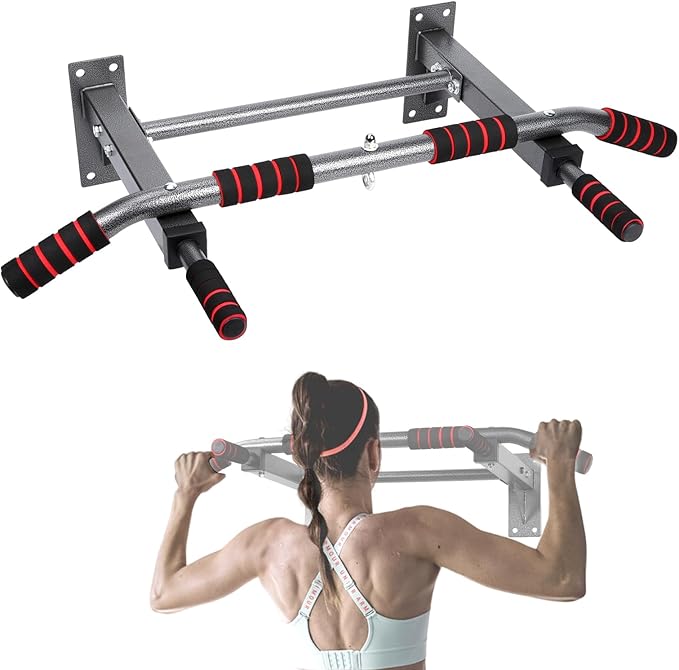
How they work: These bars attach directly to your wall with screws and brackets, providing maximum stability for more advanced exercises and heavier users.
Features to Consider:
- Wall clearance – Distance from the wall (important for muscle-ups)
- Grip variations – Multiple hand positions for targeting different muscles
- Mounting height – Proper height for full range of motion
Installation: Requires drilling into wall studs or masonry
Free-Standing Bars
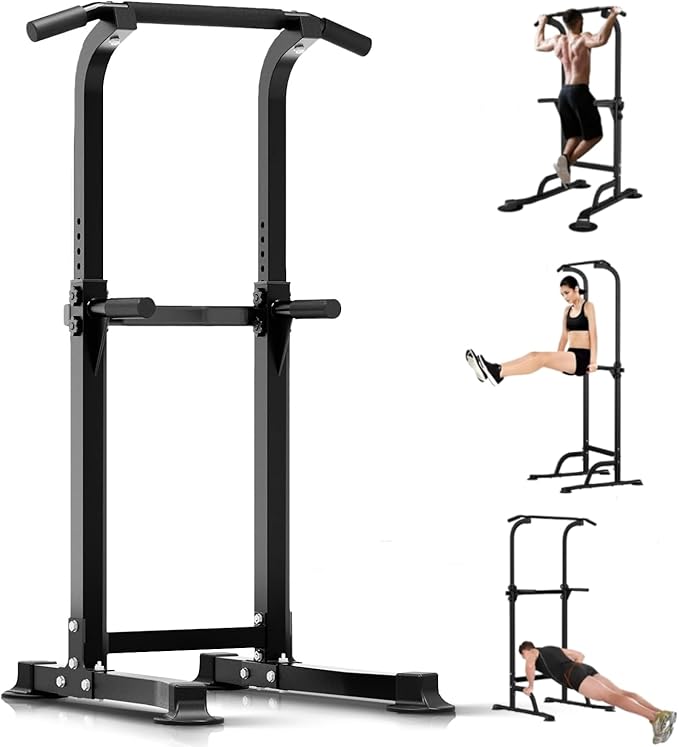
How they work: These standalone units don’t require attachment to any existing structure, making them versatile for various spaces and completely portable.
Popular Variations:
- Power towers – Include pull-up bar, dip station, and sometimes push-up handles
- Portable frames – Can be assembled/disassembled for storage
- Outdoor models – Weather-resistant for backyard or patio use
Installation: Assembly required but no attachment to home structures
Top 5 Pull Up Bar at Home Workouts
Transform your fitness with these effective pull up bar at home workout routines. Each exercise targets different muscle groups and can be modified for various fitness levels.
Essential Pull-Up Variations for Complete Upper Body Development
1. Classic Pull-Ups
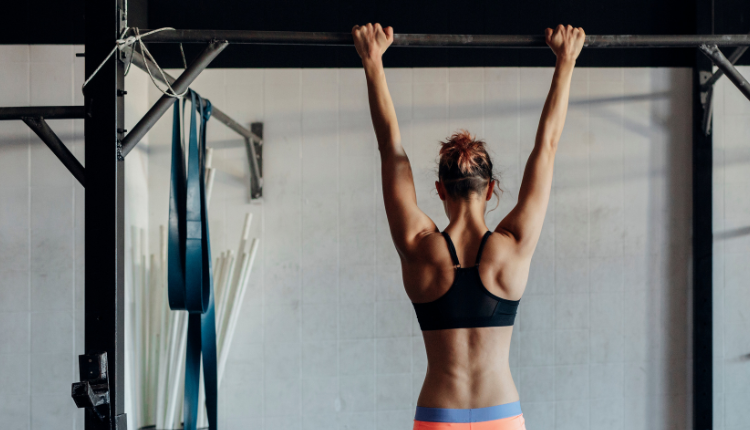
Target muscles: Latissimus dorsi (back), biceps, shoulders
How to perform:
- Grip the bar with hands slightly wider than shoulder-width apart
- Hang with arms fully extended (dead hang position)
- Pull your body up until your chin clears the bar
- Lower yourself with control to the starting position
- Aim for 3 sets of 5-10 repetitions
Beginner modification: Use a resistance band for assistance or perform negative pull-ups (jump to the top position and lower yourself slowly).
2. Chin-Ups

Target muscles: Biceps, lower lats, chest
How to perform:
- Grip the bar with palms facing toward you (underhand grip)
- Position hands at shoulder width
- Pull your body up until your chin passes the bar
- Focus on squeezing your biceps at the top
- Lower with control to full arm extension
- Aim for 3 sets of 6-12 repetitions
Why it’s effective: The underhand grip shifts more emphasis to the biceps while still engaging the back, making it excellent for balanced upper body development.
3. Leg Raises
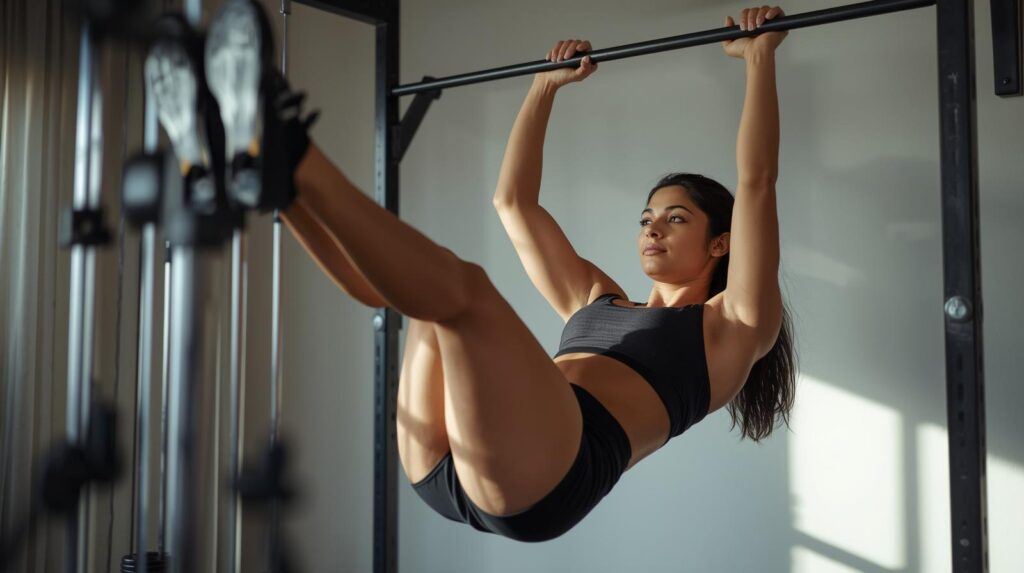
Target muscles: Lower abs, hip flexors, grip strength
How to perform:
- Hang from the bar with arms fully extended
- Keep your back straight and shoulders engaged
- Raise your legs forward until they’re parallel to the ground
- Lower them slowly with control
- Avoid swinging or using momentum
- Aim for 3 sets of 8-15 repetitions
Progression: Once comfortable with leg raises to parallel, try raising your legs all the way up to touch the bar for advanced core development.
4. L-Sit Holds
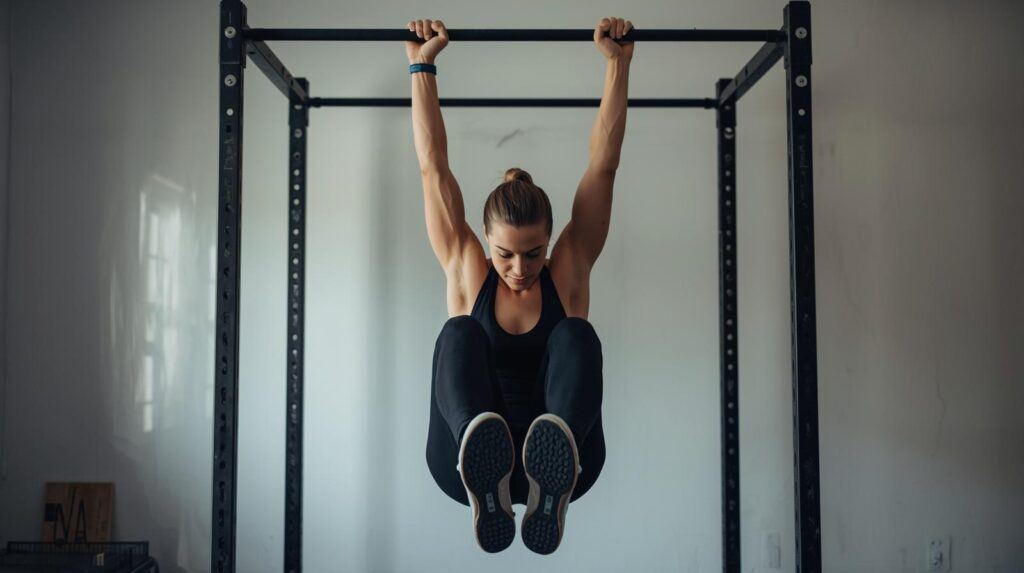
Target muscles: Core, hip flexors, quads, shoulders
How to perform:
- Hang from the bar with arms extended
- Raise your legs until they’re parallel to the ground
- Keep your legs straight and together
- Hold this L-position as long as possible
- Focus on breathing steadily throughout
- Aim for 3 sets of 10-30 second holds
Benefits: This isometric exercise builds tremendous core strength while also improving shoulder stability and grip endurance.
5. Australian Pull-Ups
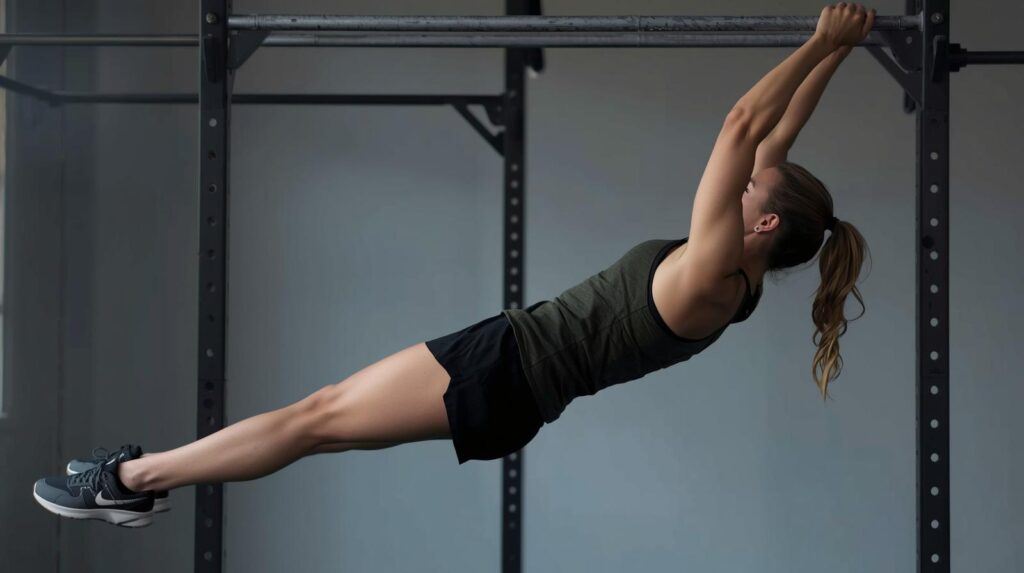
Target muscles: Upper back, rear deltoids, biceps, core
How to perform:
- Position yourself under the bar (set lower than for regular pull-ups)
- Grip the bar with hands wider than shoulder width
- Keep your body straight from head to heels
- Pull your chest up to the bar while keeping your body rigid
- Lower yourself with control
- Aim for 3 sets of 10-15 repetitions
Why it’s perfect for beginners: Australian pull-ups are an excellent progression exercise if you’re working toward full pull-ups. They build the necessary back strength while being more accessible for beginners.
Conclusion: Start Your Pull Up Bar Journey Today
A pull up bar at home is one of the most valuable fitness investments you can make. With minimal space requirements and a modest financial investment, you gain access to a complete upper body training system that can transform your strength, physique, and overall fitness level.
Whether you choose a simple doorway model, a sturdy wall-mounted system, or a versatile free-standing unit, the key is to start using it consistently. Begin with exercises that match your current strength level, focus on proper form, and gradually increase the challenge as you progress.
Remember that consistency is more important than intensity when starting out. Even if you can only hang from the bar for a few seconds or need assistance to complete a single pull-up, each session builds the foundation for future strength. Your pull up bar at home workout routine will evolve as you do, offering endless progression possibilities. Thank you for visiting my site, I wish you well in your home workout routine!
